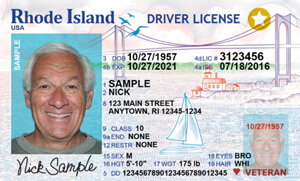- Updated for April 2025
- Based on official Rhode Island Driver's manual
Free DMV Written Test Simulator for Rhode Island | Updated for 2025
In Rhode Island, all drivers, regardless of age, must obtain an instructional permit before applying for a driver’s license. The requirements to obtain an instructional permit include being at least 16 years old and passing a vision test and a computerized Rhode Island DMV written knowledge test on driving theory. If you’re under 18, you have a few other requirements to meet first: You must begin a 33-hour classroom driver’s education course (no driving yet) at age 15 years and 10 months or older. You must complete the course before applying for the instructional permit. Also, your parent, guardian, or adult spouse must accompany you to the DMV to co-sign your application for a permit there.
All questions on the knowledge test are based on the official Rhode Island driver’s manual (Rhode Island DMV Handbook (RI Driver's Manual) 2025).
You should study the manual, but this alone may not ensure you pass the knowledge test. Could you use some help to pass it? Then you’ve certainly come to the right place! Our knowledge test preparation program is just what you need to pass the knowledge test on your first try. We guarantee it – or your money back!
Here is the second of our five Rhode Island DMV Permit Practice Tests. We designed it to help aspiring drivers like you pass the DMV knowledge test. Like the official test, this practice test is multiple choice, based on the official Rhode Island driver’s manual, and up to date as of April 2025.
You can start this practice test right now. Please read the first test question and its answer choices. Select the best or most complete answer. If you’re unsure of the correct answer, ask our AI Assistant to give you a hint or clarify the question. You can also ask your own questions about driving. The Progress Bar will keep track of your score. If you answer the question correctly, it will turn green in the Progress Bar. If you miss the practice question, it will turn red, and the AI Assistant will give you the correct answer and an explanation. You can retake this practice test as often as you wish until you’ve thoroughly mastered the material.
Still concerned that something might go wrong on the big test day anyway? Might you freeze up or forget something important? We have you covered there too. We also offer our own Rhode Island Permit Test Study Guide with last-minute tips for the big exam day. It covers such topics as how to prepare your mind and body for the test, what documents to have on hand, and fees you may have to pay.
- Perfect for learner’s permit, driver’s license, and Senior Refresher Test
- Triple-checked for accuracy
What you need to know

What to expect on the actual RI DMV exam
questions
correct answers to pass
passing score
minimum age to apply
List of questions (classic view)
- If you are parallel parked on the right side of the street, you should _________ before pulling out into traffic.
- Except where prohibited, you should use the three-point turn to
- When preparing to leave a parallel parking space, you should
- When two vehicles approach an uncontrolled intersection from different roadways at about the same time, the vehicle _________ has the right-of-way.
- Headrests should be adjusted so that the head restraint contacts the back of the head. This prevents
- Before passing another vehicle, you should
- All trucks and buses have
- You may not pass another vehicle except
- While driving, if you need to read a map or directions, you should
- Which of the following is not a safe situation for passing?
- To control your speed on steep downgrades, you should
- Where there are two or more lanes of traffic moving in the same direction, slower vehicles should use
- If you skid while hydroplaning, you should
- Which of the following statements about blind spots is FALSE?
- While crossing railroad tracks, AVOID
- When any vehicle turns, its rear wheels will follow a _________ than its front wheels.
- If you are approaching a stop sign, you must
- Before changing lanes, you must check for traffic
- If you are about to pass a bicycle to your right and an oncoming vehicle is approaching you on your left, what should you do?
- When you see a solid yellow centerline on your side of the road, you must
- What must you do at a flashing yellow traffic signal?
- A two-headed arrow with one head pointing straight ahead and the other pointing left means that
- Which of these statements about U-turns is FALSE?
- A driver must yield the right-of-way to other vehicles in all of the following situations EXCEPT
- A triangular orange sign on the rear of a vehicle indicates that
- Rumble strips use vibration and sound to alert drowsy or inattentive drivers that they are
- The stopping distance of your vehicle depends on which of the following factors?
- Following too closely behind a vehicle is also known as
- Warning signs are posted along the roadways to
- For better visibility in fog, rain, or snow, use
- A red arrow signal at an intersection indicates that
- When you see this sign, you should
- If you double your speed on a highway, your braking distance increases by
- What does this sign mean?
- When entering a limited-access highway from an acceleration lane, you must
- This sign is used
- When there is water on the roadway, you must reduce your speed to avoid
- What does this sign indicate?
- If you are signaled by a flagperson (flagger) at or near a railroad crossing or work zone, you must
- A barrier of grass, concrete, or other material separating opposing lanes of traffic on a divided roadway is known as
More resources
- Alabama: Test 1 / Test 2
- Alaska: Test 1 / Test 2
- Arizona: Test 1 / Test 2
- Arkansas: Test 1 / Test 2
- California: Test 1 / Test 2
- Colorado: Test 1 / Test 2
- Connecticut: Test 1 / Test 2
- Delaware: Test 1 / Test 2
- District of Columbia: Test 1 / Test 2
- Florida: Test 1 / Test 2
- Georgia: Test 1 / Test 2
- Hawaii: Test 1 / Test 2
- Idaho: Test 1 / Test 2
- Illinois: Test 1 / Test 2
- Indiana: Test 1 / Test 2
- Iowa: Test 1 / Test 2
- Kansas: Test 1 / Test 2
- Kentucky: Test 1 / Test 2
- Louisiana: Test 1 / Test 2
- Maine: Test 1 / Test 2
- Maryland: Test 1 / Test 2
- Massachusetts: Test 1 / Test 2
- Michigan: Test 1 / Test 2
- Minnesota: Test 1 / Test 2
- Mississippi: Test 1 / Test 2
- Missouri: Test 1 / Test 2
- Montana: Test 1 / Test 2
- Nebraska: Test 1 / Test 2
- Nevada: Test 1 / Test 2
- New Hampshire: Test 1 / Test 2
- New Jersey: Test 1 / Test 2
- New Mexico: Test 1 / Test 2
- New York: Test 1 / Test 2
- North Carolina: Test 1 / Test 2
- North Dakota: Test 1 / Test 2
- Ohio: Test 1 / Test 2
- Oklahoma: Test 1 / Test 2
- Oregon: Test 1 / Test 2
- Pennsylvania: Test 1 / Test 2
- Rhode Island: Test 1 / Test 2
- South Carolina: Test 1 / Test 2
- South Dakota: Test 1 / Test 2
- Tennessee: Test 1 / Test 2
- Texas: Test 1 / Test 2
- Utah: Test 1 / Test 2
- Vermont: Test 1 / Test 2
- Virginia: Test 1 / Test 2
- Washington: Test 1 / Test 2
- West Virginia: Test 1 / Test 2
- Wisconsin: Test 1 / Test 2
- Wyoming: Test 1 / Test 2
Your go-to, trusted source
Experience the Driving-Tests differenceOur commitment to accuracy and quality in our practice tests
Explore our rigorous, multi-tiered verification process that ensures each question mirrors the official manual for unparalleled accuracy.

At Driving-Tests.org, we understand the importance of reliable and accurate practice tests to help you prepare for your DMV exam. That's why we've developed a meticulous process to create and continually update our practice questions, ensuring they reflect the most current driving laws and regulations.
Here's an inside look at how we maintain the highest quality in our practice tests.
Content Creation and Verification Process
- Alignment with Official Manuals:
Every question we develop is based on the most recent version of each state's official driving manual. Our team regularly monitors each state DMV's website for the latest updates to ensure our practice tests are always aligned with the most current information. - Community Feedback Integration:
We leverage feedback from our vast community of users to understand which topics are most frequently tested. This helps us focus on the areas that are most relevant and beneficial for your preparation. - Expert Content Creation:
Our in-house editor, Steven, who has extensive experience in driver education, crafts each question with precision. He conducts a thorough review of each question against the official manuals to ensure accuracy. - Rigorous Review Process:
Once Steven has finalized a set of questions, our team conducts a joint review session. This second level of scrutiny involves content accuracy, proofreading, and fact-checking to eliminate any errors. - User Feedback Mechanism:
After a question goes live on our site, we keep the lines of communication open. Each question features a feedback button, inviting users to report any issues or errors. This continuous feedback loop allows us to address and rectify any concerns promptly. - Responsive Updates:
In line with our commitment to accuracy, we quickly update our practice questions to reflect any changes in the DMV manuals. Additionally, we update the free electronic copy of the state's driver's license manuals on our site, typically within a few days after the DMV publishes them.
Our thorough quality control process ensures that you have access to practice tests that are as accurate and up-to-date as possible. We believe in the power of well-prepared drivers and are dedicated to providing you with the best study tools to help you succeed on your DMV exam.
Before you view your test results, discover how you can pass faster with Premium:
- Real Exam-Like Rhode Island QuestionsGet 650+ questions seen on the real test
- Money-Back GuaranteeIf you don't pass, it costs you nothing
- 97% Premium Users Pass on Their First TryCompare with the average US passing rate of 49%





Trusted by 1.15 Million drivers
